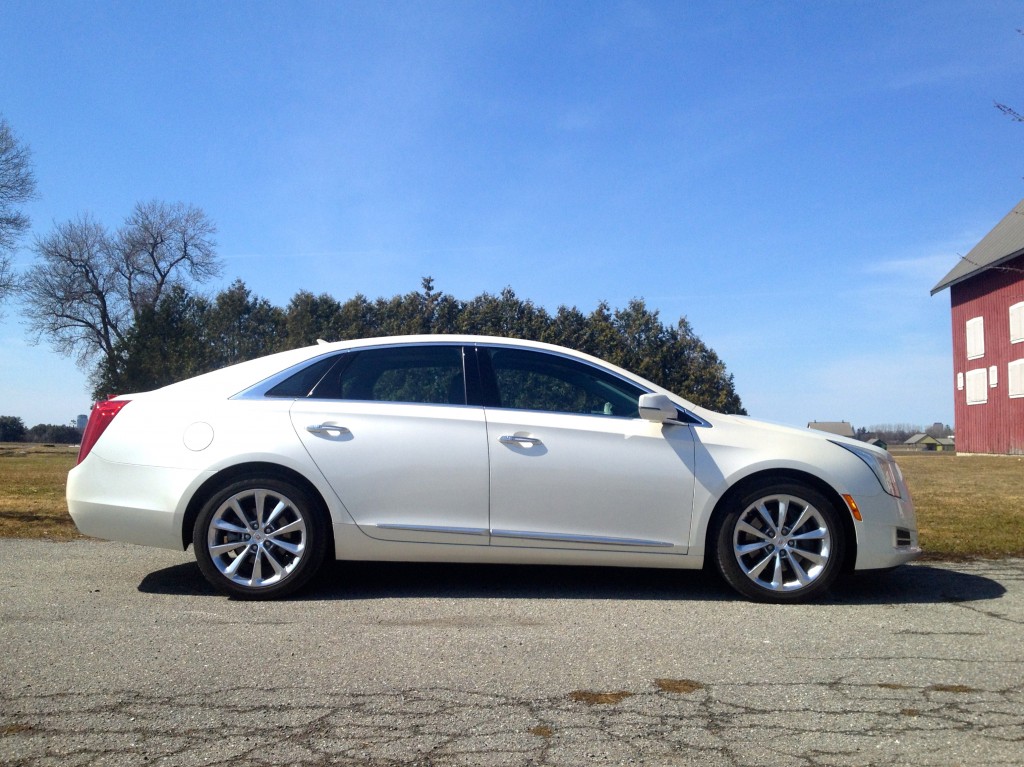Road Test: 2013 Cadillac XTS
Story by John LeBlanc
If 19th-century writer Charles Dickens was alive and well and penning about cars today, he’d no doubt title his review of the new Cadillac XTS as A Tale of Two Cadillacs. On one hand, the new-this-year, full-sized sedan tries to keep traditional Cadillac buyers in the fold, while at the same time attempting to allure customers who may not already be cashing Canada Pension cheques.
Technically, 2013 XTS replaces the decrepit Cadillac DTS, an aging, front-wheel-drive barge that was around since 1996, and bought by only 227 Canadians (out of a total of more than 7,500 Cadillacs sold) in its last calendar year on sale in Canada, 2011.
Seemingly to save parent General Motors a few development dollars — and unlike the rear-wheel-drive compact ATS or mid-sized CTS sedans — the full-sized XTS shares its front- or all-wheel-drive platform with more plebeian GM four-doors, namely the Buick LaCrosse and new 2014 Chevrolet Impala. All three ride on an enlarged version of GM’s Epsilon II global platform. (The XTS and Impala are built on the same line in GM’s Oshawa, Ont., plant).

Because all-wheel-drive is a must-have for most luxury car buyers in Canada, like the LaCrosse, traction at all four wheels is optional on the XTS sedan. But my $60,815 (price includes $10,175 in options and a $1,650 freight and pre-delivery inspection charge) 2013 Cadillac XTS tester was a front-wheel-drive version, with the same, 300-horsepower and 264 pound-feet of torque 3.6-litre six-cylinder gas engine mated to the same six-speed automatic transmission as its Chevy and Buick cousins.
Unlike other so-called flagship sedans, there’s no V8 option on the XTS menu, which is probably just fine for the few returning DTS buyers the new XTS seems targeted toward. While the V6 delivers descent acceleration (zero to 100 /h takes 6.8 seconds) and fuel economy numbers (I saw an as-tested 9.8 L/100 average), there’s almost zero of the sportiness new-age Cadillacs — like the 2013 ATS 3.6 AWD I recently tested — exude.
The XTS’s steering is one-finger-light and not very communicative with what’s going on down at road level. Counter to rock-solid German rivals, the Cadillac’s body structure feels loosey-goosey, with bad pavement felt and heard by passengers. And while Cadillac spouts on about the XTS being equipped with the brand’s excellent Magnetic Ride Control shock absorbers and a rear air suspension, the ride and handling balance doesn’t deliver ATS-like athletic driving dynamics. Yet the ride is so firm, it also fails as a quiet, comfortable cruiser on anything less than perfect pavement.

So the new XTS won’t inspire its owners to book a trip to Germany to flog it around the Nürburgring racetrack. Fair enough. But in an attempt to keep up with gadget-laden competition, Cadillac designers have gone overboard in making the interior ergonomics of the XTS potentially confusing for traditional DTS customers.
Like the Impala and LaCrosse, the XTS offers a roomy and comfortable interior. Rear legroom is particularly generous, but while there’s plenty of leather-covered-this and chrome-trimmed-that, the Cadillac User Experience (or CUE) system is hard to use, no matter how old you are.
While some automakers have tried to reduce the number of centre dash buttons via a central controller, the CUE system has almost as many buttons as a conventional design. Most frustrating is the fact that the buttons are inconsistent in their use. At times, I had to make several attempts to activate the haptic (a tactile feedback technology that senses touch) buttons. The centre dash screen (that contains many of the basic audio and climate controls that would normally be handled by a few knobs) is also a long reach away.

A week driving the sedan only cemented the XTS’s conundrum. Unlike new-age models like the ATS and CTS, the XTS is a throwback to old school Cadillacs, where comfort and features were more important than great driving characteristics. But in an attempt to be hip with the younger crowd, I can only see the XTS’s CUE system frustrating to returning DTS buyers and its quasi-sporty driving characteristics off-putting, too. The new Impala’s centre dash adds more conventional knobs and buttons, and is easier to use because of it. And therein lies perhaps the biggest hurdle for the new XTS: lack of value.
Although Cadillac calls the new XTS its flagship sedan, it really isn’t. GM’s luxury brand has all but admitted that the XTS is a stopgap model until a true, rear-wheel-drive flagship sedan (to compete against the likes of the BMW 7 Series and Mercedes-Benz S Class) arrives in a few years. And for about $5,000 less than the Cadillac sedan’s $48,995 base price, I can get a loaded 2014 Chevy Impala with the same powertrain, same interior room and the majority of the XTS’s luxury, convenience and safety features. If I was on a fixed income, I know which GM full-sized sedan I would buy.
Road Test: 2013 Cadillac XTS
Type of vehicle Front-wheel-drive full-sized luxury sedan
Engine 3.6L DOHC six-cylinder
Power 304 hp @ 6,800 rpm, 264 lb-ft of torque @ 5,200 rpm
Transmission Six-speed automatic
Brakes Four-wheel disc with ABS
Tires P245/45R19
Price: base/as tested $48,995/$59,165
Destination charge $1,650
Natural Resources Canada fuel economy L/100 km 12.1 city, 7.2 highway, 9.8 as-tested
Standard features OnStar, fog lights, rear parking assist, 19-inch aluminum wheels, automatic climate control, Bose AM/FM/CD/MP3 audio system with USB/SD/AUX inputs, on-board trip computer, tire pressure monitoring, automatic locks, smart key with push-button start, 10-way power driver’s seat with memory, heated and ventilated front seats, auto dimming rear-view mirror, Bluetooth, steering-wheel mounted controls, leather-wrapped power tilt/telescopic steering wheel, universal garage door opener, power one-touch windows.






![[del.icio.us]](https://www.straight-six.com/wp-content/plugins/bookmarkify/delicious.png)
![[Digg]](https://www.straight-six.com/wp-content/plugins/bookmarkify/digg.png)
![[Facebook]](https://www.straight-six.com/wp-content/plugins/bookmarkify/facebook.png)
![[Google]](https://www.straight-six.com/wp-content/plugins/bookmarkify/google.png)
![[Reddit]](https://www.straight-six.com/wp-content/plugins/bookmarkify/reddit.png)
![[StumbleUpon]](https://www.straight-six.com/wp-content/plugins/bookmarkify/stumbleupon.png)
![[Twitter]](https://www.straight-six.com/wp-content/plugins/bookmarkify/twitter.png)
![[Email]](https://www.straight-six.com/wp-content/plugins/bookmarkify/email.png)